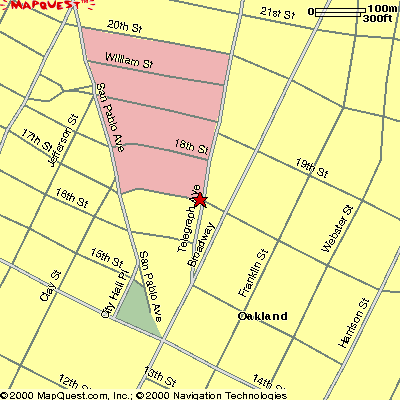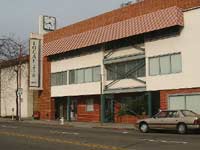|
AS REDEVELOPMENT
BRINGS THE WRECKING BALL CLOSER, ONE DOWNTOWN NONPROFIT GIRDS FOR A FIGHT
By
Rosemary Hoban
One look at downtown Oakland after dark, with its empty storefronts and
littered streets, and it’s hard to argue with Mayor Jerry Brown’s
much-publicized "10K" revitalization plans. City press releases
crow about Brown’s initiative to bring 10,000 new residents to the
city center and predict that with them will come activity, life and economic
benefit.
If you’re the right kind of resident. But if you’re a low-income
resident, a non-profit organization, or can’t pay dot-com level rents,
you might be a loser.
Just ask Dan Martin, who works for the Service Employees International
Union, Local 250, California’s largest union local. In 1992, the
50,000 member strong organization made a commitment to Oakland, when others
were leaving, by bringing its headquarters downtown. The union bought
a vacant photo lab on 20th Street, near the Greyhound Bus Station. The
area was dreary, without greenery, and the new neighbors were a PG&E
substation and a parking lot.
The union spent $2.5 million to buy the 35,000 square foot building, renovate
it and do a seismic retrofit. It's not an architectural gem –a big,
flat, white and brick building that looks like a warehouse in a row of
similar buildings. But inside is a buzz of activity. Offices lining the
main atrium are filled with 80 union organizers, benefits managers and
clerical staff. There is a constant hum.
"The building gets use not just from our members but from people
in the community," said Dan Martin, assistant to union president.
"It's a community resource, especially for a lot of politically progressive
organizations."
Now the building may be threatened by a massive project that proposes
to fit 2000 new housing units and 100,000 square feet of retail space
into the surrounding five-block chunk of real estate bounded by 17th and
21st Street and Telegraph and San Pablo Avenues. Jens Hillmer, a senior
housing development coordinator with the Oakland Community and Economic
Development Agency, said current plans designate the block on 20th Street
as the best location for new residents’ parking, and that the SEIU
building may become a parking structure.
But it’s not just buildings that may be leveled in this process.
Residents in the surrounding neighborhoods, low-volume businesses, non-profits
and arts groups face being flattened by the rising tide of prosperity
and the increased rents that have come with it. And the project isn’t
even built yet.
SEIU and non-profits complain that they moved downtown when no one else
would and anchored the neighborhoods with workers during the day and rental
income for building owners. Now they say they want their due.
"We're willing to work with the city on this, but not if it means
leaving downtown Oakland," Martin said. "The problem is that
we're looking for replacement value to buy a new building, not market
value on this building."
That's going to cost a lot of money. At today’s prices, Martin says,
the cost of relocating to another downtown location, renovating and doing
the seismic refit would amount to $ 4 - 5 million more than the market
value of SEIU’s current building. He said he has been shown other
buildings - one priced at $4.5 million and requiring an additional $4
million of work to make it habitable.
"I don't understand how that works," Martin said. "We're
a worker's organization. We can't come up with $ 4-5 million extra to
get essentially what the city is taking from us for granted."
David Herr, a downtown commercial real estate agent, confirmed Martin’s
numbers. "The price of office space in Oakland has skyrocketed in
the past five years," Herr said. "There's no incentive for owners
to sell when rents are so good."
Herr said buildings for sale are now "few and far between,"
and that the rapid rise in value has made selling long-held buildings
unprofitable. "The owners would have to pay ridiculous capital gains
taxes," he said. "It's not worth it to them."
When asked about other potential losers in the redevelopment process,
Oakland City Council President Ignacio De La Fuente responded with surprise.
"I like to believe that everyone in the redevelopment process are
winners," he said.
But many people disagree.
"There are definitely losers in this process," said Arthur Goldman,
a downtown real estate broker and president of the Central Business District
of Oakland. Goldman said he has been called to help relocate non-profit
organizations, arts groups, small businesses and even church groups that
could no longer afford rising rents downtown. He said relocating these
groups was becoming harder as the supply dries up.
But Goldman also cited improvements downtown, such as less litter, more
people and a feeling that change is in the air. He pointed out that the
proposed uptown development area included the dilapidated Fox Theater
and the U.S. Ice Center ice rink, which stand to gain from the redevelopment
process.
"You can't have it both ways," Goldman said. "You have
to have a firm understanding that if you want to save everything, nothing
changes."
Other redevelopment opponents are more strident.
"There are people who've been downtown for 5, 10, 30 years,"
said the Rev. Susan Starr of the West Downtown Neighborhood Alliance.
"I believe that these people have a right to stay in their homes
unless they mess up."
Starr predicted that more than half the current downtown residents (herself
included) would be priced out of the housing market once redevelopment
projects are built, in two to three years. She blamed the coming dislocation
on the lack of a just-cause evictions law in Oakland. She said that under
current laws, a landlord can give a tenant 30 days notice to vacate. Once
the tenant is gone, the landlord can raise the rent to market value.
According to Starr, once downtown becomes a more desirable place to live
and rents rise, landlords will evict low-paying tenants and there will
be wholesale displacement.
"Nothing has happened yet, but it will," Starr said. "The
problem is that there is no plan to maintain racial and economic diversity
downtown. If you don't do that, you'll end up with a downtown San Francisco
- a place where only rich people can live."
CEDA’s Hillmer said city officials would see to it that anyone who
lived within the redevelopment area would be compensated for their property
and displaced homeowners would get replacement housing. As it stands,
the project plan calls for 20% of the housing to be set aside as "affordable,"
aimed at people who earn the Alameda County median family income of $65,700.
"But for people who live in adjacent neighborhoods that might gentrify
as a result of redevelopment, they’ll have to look for housing somewhere
else in Oakland," Hillmer said.
For some non-profits, the future is now, as they face displacement in
the coming months. Michael Daniels, Director of the Jobs Consortium, an
organization that provides job training and placement for the homeless,
expresses frustration when he talks about what is happening to non-profits
in the current real estate market.
According to Daniels, during the early 1990’s, property owners and
developers recruited non-profits to fill otherwise undesirable office
spaces downtown. He complains that now the market is hot, non-profits
are being put out of spaces they helped to make viable in the first place.
His organization lost its lease earlier this year and was forced to move
into a smaller space.
"Non-profits organizations like the Jobs Consortium really helped
turn around the real estate market" he said. "But when everyone
was courting us into their buildings, who knew that a few years afterwards
they’d be giving us eviction notices?"
Meanwhile, representatives from SEIU and Oakland officials met for the
first time in the beginning of November, almost nine months after the
redevelopment plans were originally unveiled. Union officials acknowledges
that they have both money to defend themselves and the advantage of a
large voting bloc in the form of union members. "We have almost 50,000
members in the local," said SEIU’s Martin. "If we need
to surround the building with 1,000 workers to keep the City from confiscating
it, that's what we'll do."
But Martin sees the limitations of this approach. "Fortunately, we
have a little bit of power, " he said. "But I don't know what
the little guys who are in this position do."
Sidebar
Home
|

The
area proposed for the Forest City Cevelopment plan in uptown Oakland.

20th
Street and the SEIU building, which may become a parking lot if plans
go through.
|

